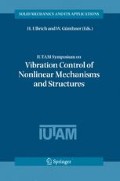Abstract
A modified optimal linear control algorithm is proposed to demonstrate the effectiveness of the active control system in reducing inelastic structural dynamic responses using elastic displacement feedback. Effectiveness of the proposed algorithm is then demonstrated by studying the control energy of the controlled structure. Numerical simulation using various single degree of freedom systems is performed and results show that there always exists a point where the control energy dissipation is maximal, and this optimal point is dependent on the structural characteristics as well as the earthquake excitation.
Access this chapter
Tax calculation will be finalised at checkout
Purchases are for personal use only
Preview
Unable to display preview. Download preview PDF.
References
Hart, G.C. and Wong K. (2000). Structural Dynamics for Structural Engineers, John Wiley and Sons, New York, pp. 556–568.
Reinhorn, A.M., Manolis, G.D. and Wen, C.Y. (1987). Active control of inelastic structures, Journal of Engineering Mechanics ASCE 113:315–333.
Soong, T.T. (1990). Active Structural Control, Theory & Practice, Longman Scientific and Technical, U.K.
Wong, K.K.F. and Yang, R. (1999). Inelastic dynamic response of structures using force analogy method, Journal of Engineering Mechanics ASCE 125:1190–1199.
Yang, J.N. (1984). Application of optimal control theory to civil engineering structures, Journal of Engineering Mechanics ASCE 101:819–838.
Yang, J.N., Li, Z. and Liu, S.C. (1991). Instantaneous optimal control with velocity and acceleration feedbacks, Journal of Probabilistic Engineering Mechanics 16:204–221.
Yang, J.N., Li, Z. and Liu, S.C. (1992a). Stable controllers for instantaneous optimal control, Journal of Engineering Mechanics ASCE 118:1612–1630.
Yang, J.N., Li, Z., Danielians, A. and Liu, S.C. (1992b). Aseismic hybrid control of non-linear and hysteretic systems I, Journal of Engineering Mechanics ASCE 118:1423–1440.
Yang, J.N., Li., Z., Danielians, A. and Liu, S.C. (1992c). Aseismic hybrid control of non-linear and hysteretic systems II, Journal of Engineering Mechanics ASCE 118:1441–1456.
Author information
Authors and Affiliations
Editor information
Editors and Affiliations
Rights and permissions
Copyright information
© 2005 Springer
About this paper
Cite this paper
Wong, K.K.F. (2005). Structural Control Energy Efficiency Based on Elastic Displacement. In: Ulbrich, H., GÜnthner, W. (eds) IUTAM Symposium on Vibration Control of Nonlinear Mechanisms and Structures. Solid Mechanics and its Applications, vol 130. Springer, Dordrecht. https://doi.org/10.1007/1-4020-4161-6_33
Download citation
DOI: https://doi.org/10.1007/1-4020-4161-6_33
Publisher Name: Springer, Dordrecht
Print ISBN: 978-1-4020-4160-0
Online ISBN: 978-1-4020-4161-7
eBook Packages: EngineeringEngineering (R0)

